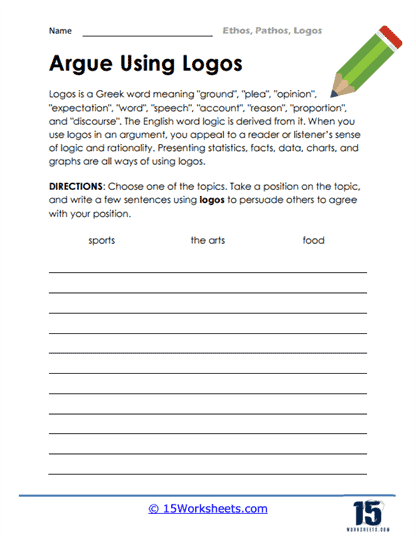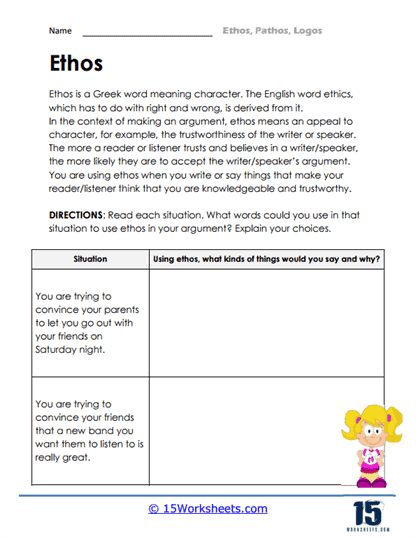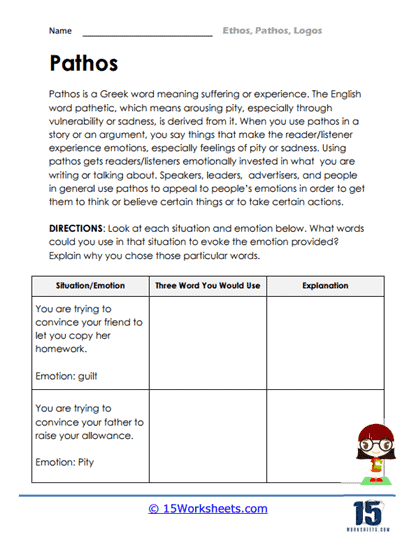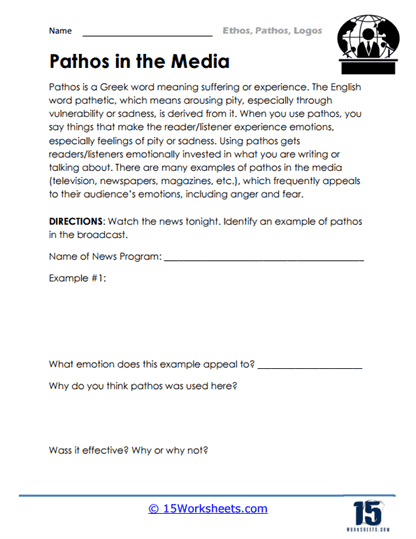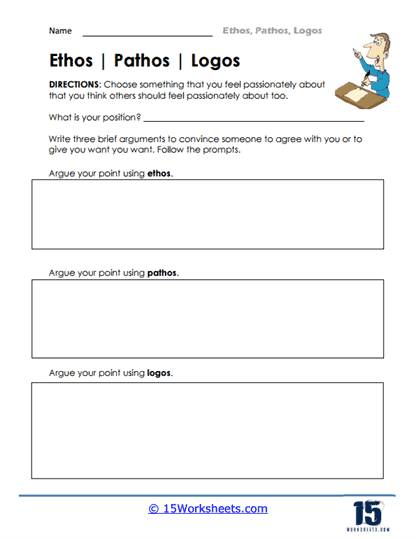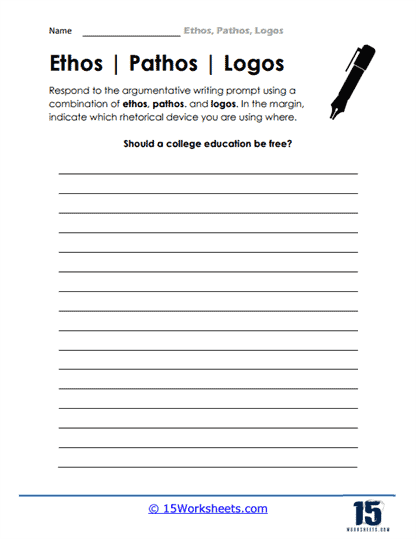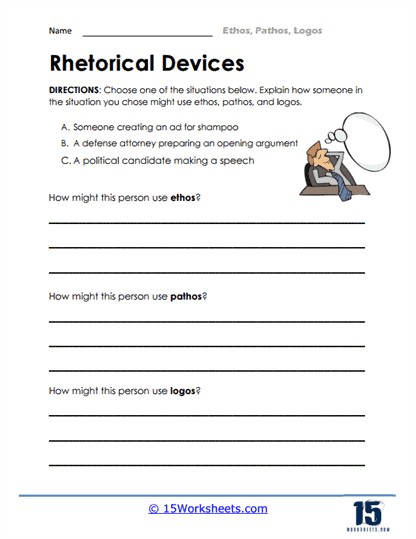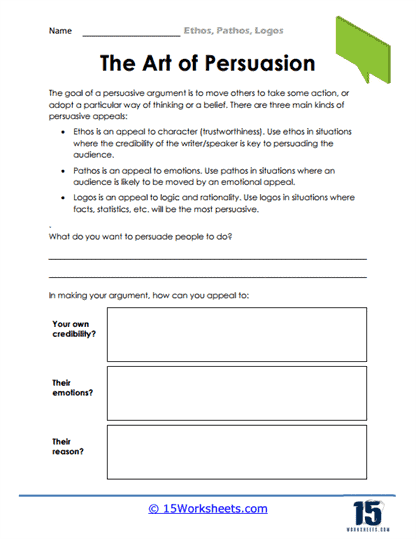Ethos, Pathos, Logos Worksheets
All About These 15 Worksheets
This collection of Ethos, Pathos, and Logos worksheets are meticulously crafted to help students understand and recognize these three modes of persuasion commonly used in writing and speech.
These worksheets include a variety of exercises and activities to help students identify and analyze examples of ethos, pathos, and logos in written and spoken texts. Some examples of these activities include:
Reading comprehension exercises – Students read a text and identify examples of ethos, pathos, and logos.
Writing exercises – Students write their own persuasive text using ethos, pathos, and logos.
Situational response exercises – Students respond to various scenarios using ethos, pathos, and logos.
Here’s a playful-yet-insightful five‑paragraph romp through the Ethos, Pathos, Logos worksheets-grouped by the core persuasive muscles they flex:
1. Grasping the Golden Trio
We begin with “Define With Examples,” “Rhetorical Devices Decoded,” and “The Persuasive Trio.” Imagine students circling ethos, pathos, and logos like they’re choosing toppings at a pizza joint-“I’ll have one slice of credibility, one of emotion, one of logic, please.” These worksheets present clear definitions and relatable examples. They poke fun at students’ tendency to confuse ethos with eczema-“Nope, ethos is about trust, not itchy skin.” Then they walk students through the trio in unison: pick apart a famous quote or ad and identify which slice of persuasion is doing the heavy lifting (and what cheese it’s dripping with).
2. Diving Into Credibility (Ethos)
Next up: “The Ethos Effect,” “The Credible Voice,” and “Rhetorics in Advertisement.” These focus on the ethical, authority‑building side of persuasion. Picture students investigating whether that sweaty celebrity selling toothpaste actually a dentist. These worksheets task them with sniffing out credentials, tone, and ethos-traps-like when someone says, “Trust me, I have a degree… in soap operas.” Ads and speeches are scrutinized: does the speaker sound steady, reliable, maybe even bore‑you‑to‑sleep credible?
3. Pulling Heartstrings (Pathos)
Enter “Pathos Power,” “Tapping into Emotions,” and “Emotional Appeals in Media.” Here students become emotional detectives: dissect tear‑jerking animal shelter ads, love‑spoof commercials, even political ads promising puppies and peace. These worksheets prompt them to rate intensity (“Do I weep uncontrollably?”) and note devices like melodrama, imagery, and sentimental music. Bonus: a “Guilty‑pleasure radar” to detect chocolate‑is‑happiness manipulation in every food commercial.
4. Logic, Reason, and the Nerdy Charm (Logos)
The brainiacs rejoice with “The Force of Logos,” “Unleashing Logical Appeal,” and “Building a Strong Case.” These are heavy‑duty logic workouts. Students are fed faulty syllogisms like, “All cats are mammals; Fluffy is a cat; Fluffy can solve algebra-so all cats can solve algebra.” Cue intense eye‑rolling and correcting. Arguments are ripped apart: claim, evidence, reasoning-and bonus “Does this actually compute?” checkboxes. They learn to spot straw man ninjas and slippery slope gremlins lurking in text.
5. Real‑World Application & Critical Eyes
“Using Rhetoric in Context,” “Read Between the Lines,” and “The Persuasion Playbook.” These advanced missions ask students to mix ethos, pathos, and logos like persuasive cocktail masters. They analyze real editorial cartoons, memes, tweets, and speeches. They annotate with flair: “Here’s where logos gets lonely, ethos gets sweaty, and pathos throws a party.” They practice crafting their own miniature persuasion schemes-like a cheeky memo convincing the teacher to assign no homework on Fridays. Or perhaps just essays.
Together, this collection guides students from basic definitions to nuanced critique-and even cheeky creation-of persuasive techniques. The tone is funny (“Don’t let pathos make you sob like you lost your last French fry”) but the thinking is deep: they explore why these devices work and when they tip into manipulation. It’s like giving students Persuasion 101-complete with a comedic professor who’s part scholar, part stand‑up comic.
What is Ethos, Pathos, and Logos?
Ethos, Pathos, and Logos are three modes of persuasion used in writing and speech. They were first introduced by the Greek philosopher Aristotle and have been widely used and studied in various fields of communication, including marketing, politics, and public speaking.
Ethos – Ethos is an appeal to credibility or trustworthiness. In persuasive writing and speech, ethos is used to establish the author or speaker as an authority on the topic being discussed. Ethos can be established through personal experience, education, professional expertise, or by citing reliable sources.
Pathos – Pathos is an appeal to emotions. In persuasive writing and speech, pathos is used to evoke emotions in the audience or reader in order to persuade them to accept a certain point of view or take a particular action. Pathos can be achieved through storytelling, the use of vivid imagery, or by appealing to the values and beliefs of the audience.
Logos – Logos is an appeal to logic or reason. In persuasive writing and speech, logos is used to present a logical argument based on evidence, facts, and statistics. Logos can be achieved through the use of analogies, comparisons, and other forms of logical reasoning.
By using these three modes of persuasion in combination, writers and speakers can create persuasive messages that are both credible and emotionally engaging, while also presenting a logical argument. Understanding ethos, pathos, and logos is important for effective communication and can help learners of English as a second language improve their ability to write and speak persuasively.





